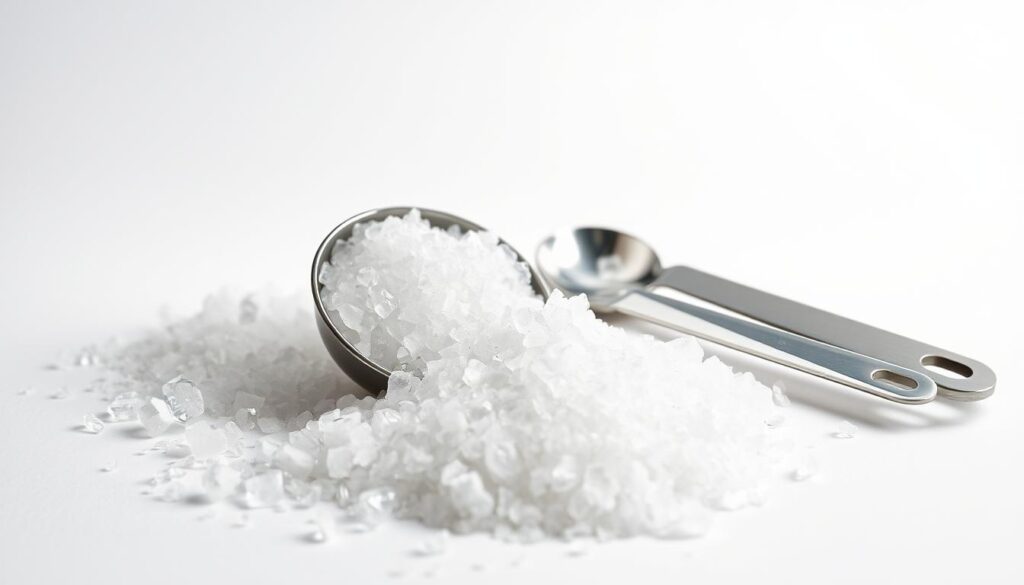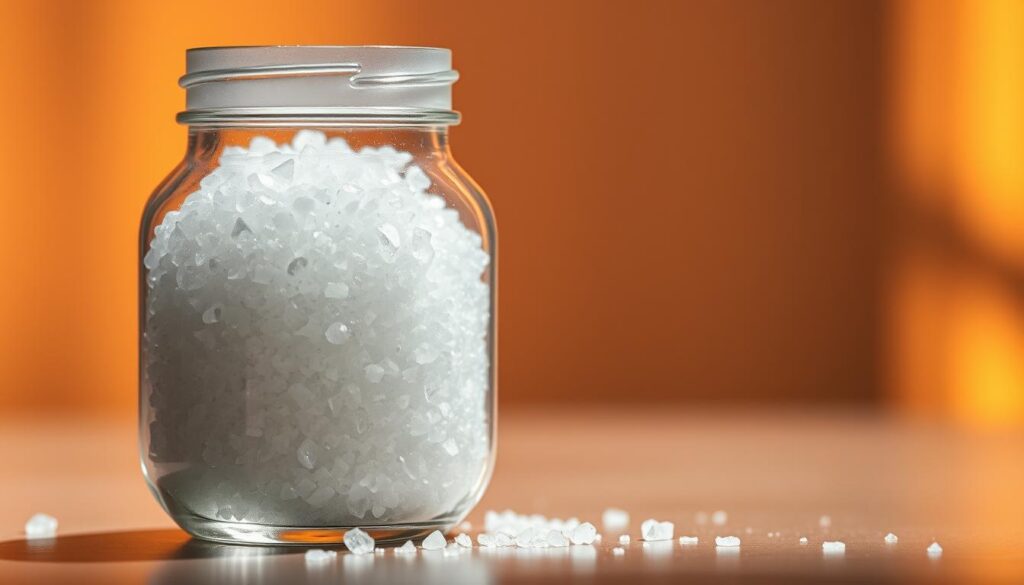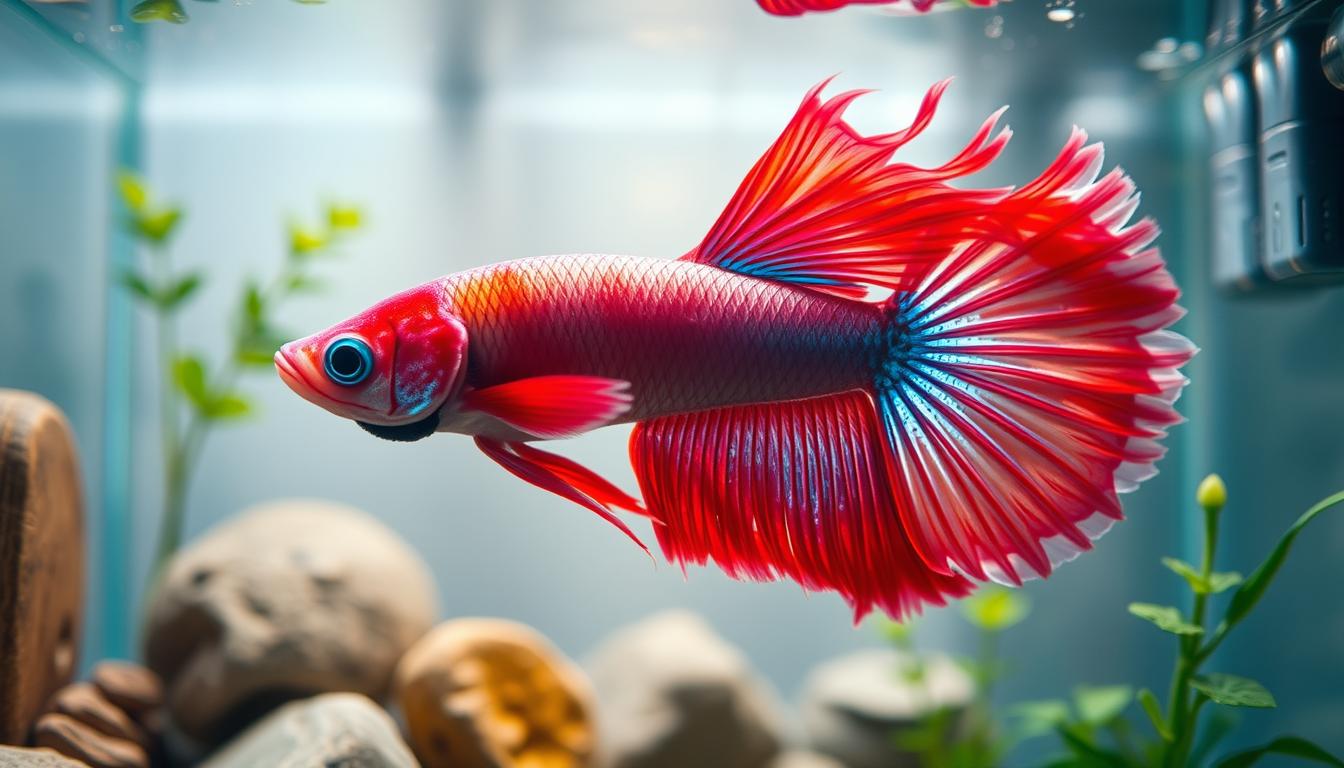If your betta is suffering from ragged or decaying fins, using aquarium salt for betta fin rot can be a simple and effective treatment. Aquarium salt for betta fin rot works by promoting healing, reducing bacteria, and easing stress in your fish. But it’s important to use the correct dosage and method, as too much salt can harm your betta.
In this guide, we’ll explain exactly how to use aquarium salt for betta fin rot, when to start treatment, and how to monitor your fish’s recovery. Whether you’re a new or experienced aquarist, understanding the proper use of aquarium salt for betta fin rot can make a big difference in your betta’s health.
Treating fin rot effectively requires understanding its causes and symptoms. One popular treatment involves using aquarium salt, which can help your betta recover. But what exactly is the right way to use it?
We’re here to guide you through the process! In this article, we’ll explore how to use aquarium salt to treat betta fin rot, ensuring your pet gets the care it needs.
Key Takeaways
- Understanding the causes of fin rot is crucial for effective treatment.
- Aquarium salt can be a helpful treatment for betta fin rot.
- Proper dosage and administration are key to using aquarium salt effectively.
- Improving water quality is essential alongside treatment.
- Monitoring your betta’s recovery is vital for adjusting treatment as needed.
Understanding Betta Fin Rot: Causes and Symptoms
Fin rot in betta fish is a common issue that can be alarming to witness, but with the right knowledge, you can tackle it head-on and get your betta back to its former glory. So, what exactly is fin rot? Simply put, it’s a bacterial infection that affects your betta’s beautiful fins.
What Exactly Is Fin Rot?
Fin rot is caused by bacteria that thrive in dirty or stressed environments. It’s not just a matter of aesthetics; fin rot can lead to more serious health issues if left untreated.
Common Causes of Fin Rot in Betta Fish
Dirty water, stress, and even injuries can make your betta more susceptible to fin rot. Some common causes include poor water quality, inadequate tank maintenance, and sudden changes in water temperature or chemistry.
Identifying the Signs and Stages of Fin Rot
Symptoms of fin rot include frayed or discolored fins, and if you notice your betta’s fins are deteriorating, it’s crucial to act fast. The stages can range from mild fraying to complete fin loss, so early detection is key.
Distinguishing Fin Rot from Other Betta Conditions
It’s essential to distinguish fin rot from other conditions that might cause similar symptoms, such as fin nipping or fungal infections. If you’re unsure, consulting with a pet care professional can provide clarity.
By understanding the causes and recognizing the symptoms early, you can take action to help your betta recover. For more betta fish health tips and fin rot remedies for bettas, keep following our guide!
The Science Behind Aquarium Salt for Betta Fin Rot
You might be wondering how aquarium salt works its magic on fin rot – we’re about to explore the science behind it! Aquarium salt works by creating an environment that’s less hospitable to bacteria and fungi, helping to promote healing.
How Salt Therapy Combats Bacterial and Fungal Infections
Salt therapy is effective against a range of pathogens. It does this by reducing the osmotic pressure, making it difficult for bacteria and fungi to survive.
Osmotic Pressure and Its Effect on Pathogens
Osmotic pressure is key here. Essentially, when salt is added to the water, it increases the salt concentration outside the pathogens’ cells, causing them to lose water and eventually die off.
Salt’s Role in Promoting Healing and Regeneration
Not only does salt help eliminate pathogens, but it also promotes healing. By reducing stress and inflammation, salt allows your betta to focus on recovering and regenerating damaged fins.
By understanding how aquarium salt works, you can make informed decisions about treating your betta’s fin rot. It’s a simple yet effective tool in your aquarium care arsenal!
Types of Aquarium Salt for Treating Bettas
Choosing the right aquarium salt is crucial for effectively treating your betta’s fin rot. Not all salts are created equal, and using the wrong type can do more harm than good.
Aquarium Salt vs. Table Salt vs. Epsom Salt
When it comes to salt, there are several types to consider, but not all are suitable for your betta’s tank. Aquarium salt is specifically designed for aquarium use, making it the best choice for treating fin rot. Unlike table salt, aquarium salt doesn’t contain additives like iodine or anti-caking agents that can harm your fish.
Table salt, while seemingly a convenient option, can be risky due to these additives. Epsom salt, on the other hand, is sometimes used in aquariums but for different purposes, such as reducing stress or treating constipation. It’s not a substitute for aquarium salt when treating fin rot.
Recommended Brands for Betta Treatment
Some trusted brands for aquarium salt include Seachem, API, and Tetra. These brands offer high-quality products that are safe for your betta and effective against fin rot. When choosing a brand, look for products labeled as “aquarium salt” or “fish-safe salt.”
- Seachem: Known for their high-quality aquarium products, Seachem’s salt is a popular choice.
- API: API’s aquarium salt is designed to promote healthy gill function and reduce stress.
- Tetra: Tetra’s aquarium salt is another reliable option for betta owners.
What to Look for When Purchasing Aquarium Salt
When purchasing aquarium salt, ensure it’s specifically designed for aquarium use. Check the label for any warnings or recommended dosages. It’s also a good idea to read reviews or ask for recommendations from experienced betta owners or aquarium professionals.
By choosing the right type of aquarium salt and following the proper treatment guidelines, you can effectively treat your betta’s fin rot and help them recover.
Proper Dosage of Aquarium Salt for Betta Fin Rot
When it comes to treating betta fin rot, getting the aquarium salt dosage right is crucial! You want to ensure you’re giving your betta the best chance to recover without risking their health. So, how much aquarium salt should you use?
General Dosage Guidelines
The general rule of thumb is to start with a dose of 1 teaspoon of aquarium salt per gallon of water. This is a good starting point, but it’s essential to monitor your betta’s response and adjust accordingly.
Adjusting Dosage Based on Severity
The severity of the fin rot can affect the dosage. For mild cases, the standard 1 teaspoon per gallon might be sufficient. However, for more severe cases, you might need to increase the dosage slightly. But be cautious – too much salt can be harmful!

Maximum Safe Concentration for Bettas
Bettas can tolerate a certain level of salt, but there’s a maximum safe concentration. Generally, you shouldn’t exceed 3 teaspoons per gallon. Staying within this range helps prevent stressing your betta further.
Calculating the Right Amount for Your Tank Size
To calculate the right amount, simply multiply the number of gallons in your tank by the desired dosage. For example, a 5-gallon tank with a desired dosage of 1 teaspoon per gallon would require 5 teaspoons of aquarium salt. Easy peasy!
| Tank Size (Gallons) | Dosage (Teaspoons) | Maximum Safe Dosage (Teaspoons) |
|---|---|---|
| 5 | 5 | 15 |
| 10 | 10 | 30 |
| 20 | 20 | 60 |
By following these guidelines and being mindful of your betta’s condition, you can effectively use aquarium salt to treat fin rot and help your betta thrive.
Step-by-Step Guide to Using Aquarium Salt for Fin Rot
Ready to give your betta the best chance at recovery? Let’s walk through how to use aquarium salt for fin rot! Using aquarium salt effectively is crucial for treating fin rot in betta fish. Here’s a step-by-step guide to help you through the process.
Preparing a Salt Bath Treatment
A salt bath can be a great way to treat fin rot without immediately affecting your entire tank’s water chemistry. To prepare a salt bath, you’ll need a separate container that’s clean and free of any contaminants. Fill this container with water from your betta’s tank, making sure it’s well-oxygenated. The ideal temperature should match your betta’s tank temperature to avoid shocking your fish.
Dosage is key: For a salt bath, you typically want to use 1-2 teaspoons of aquarium salt per gallon of water. Make sure to dissolve the salt fully before adding your betta to the bath.
Adding Salt to the Main Tank
If you decide to treat your betta directly in its main tank, you’ll need to calculate the correct dosage based on the tank’s volume. Start with a low dose of 1 teaspoon per gallon, and monitor your betta’s response. You can gradually increase the dosage if needed, but always be cautious of over-salting.
It’s also crucial to remove any plants or tank mates that might be sensitive to salt before starting the treatment.
Setting Up a Hospital Tank for Treatment
A hospital tank is a dedicated tank for treating sick fish. When setting up a hospital tank for salt treatment, ensure it’s equipped with a heater and a sponge filter (to prevent your betta from getting injured). The water should be dechlorinated and matched to your betta’s current tank temperature.
Once your hospital tank is set up, you can proceed with the salt treatment as you would in a salt bath, carefully monitoring your betta’s condition.
Monitoring Your Betta During Treatment
Keep a close eye on your betta during salt treatment. Look for signs of stress, such as rapid breathing, lethargy, or loss of appetite. If you notice any of these symptoms, you may need to adjust the salt dosage or discontinue the treatment.
“The key to successful treatment is observation and patience. Your betta’s health is worth the extra attention.”
Read Also 75 Gallon Aquarium Weight: Full Guide (Empty, Filled & With Stand)
Proper Salt Dissolution Techniques
To avoid shocking your betta, it’s essential to dissolve the aquarium salt properly. You can do this by adding the salt to a small amount of tank water in a separate container, stirring until it’s fully dissolved, and then adding this saltwater mixture to your tank or bath.
Let’s summarize the key steps for using aquarium salt for fin rot in a handy table:
| Treatment Method | Dosage | Precautions |
|---|---|---|
| Salt Bath | 1-2 tsp/gallon | Monitor betta’s response, ensure proper dissolution |
| Main Tank Treatment | Start with 1 tsp/gallon | Remove sensitive plants/tank mates, monitor betta |
| Hospital Tank | As per bath or tank treatment | Ensure proper setup (heater, sponge filter), monitor betta |
By following these steps and being mindful of your betta’s response, you can effectively use aquarium salt to treat fin rot and help your fish recover.
Water Quality and Its Impact on Treatment Success
Maintaining pristine water quality is crucial when treating your betta for fin rot! You might be using aquarium salt to combat the issue, but if your water parameters are off, you’re fighting an uphill battle.
Optimal Water Parameters During Salt Treatment
During salt treatment, it’s essential to monitor your water parameters closely. Keep your water temperature between 76-82°F (24-28°C), pH between 6.5-7.5, and ensure zero ammonia and nitrite levels. Regular water changes will help maintain these optimal conditions.
The Importance of Water Changes
Performing regular water changes is vital during treatment. It helps remove toxins and excess salt, keeping your betta healthy and stress-free. Aim for 25-50% water changes every few days, depending on your tank’s condition.
Testing and Maintaining Water Chemistry
Invest in a good water test kit to monitor your tank’s chemistry. Regular testing will help you catch any imbalances before they become major issues. It’s better to be safe than sorry!
Filtration Considerations During Treatment
During salt treatment, you might need to adjust your filtration. Some filters can cause excessive water circulation, stressing your betta further. Consider adjusting the flow or using a sponge filter to create a more comfortable environment.
| Water Parameter | Ideal Range | Why It Matters |
|---|---|---|
| Temperature | 76-82°F (24-28°C) | Comfortable temperature reduces stress on your betta |
| pH | 6.5-7.5 | Stable pH helps prevent additional stress |
| Ammonia/Nitrite | 0 ppm | Toxic compounds can severely harm your betta |

By maintaining optimal water quality and following these guidelines, you’ll be giving your betta the best chance to recover from fin rot. Remember, treating fin rot isn’t just about using the right remedies; it’s also about creating a healthy environment for your betta to thrive!
Duration and Frequency of Aquarium Salt Treatments
How long should you treat your betta with aquarium salt for fin rot? The answer lies in understanding the treatment process. Treating fin rot in bettas requires a careful approach, and the duration of aquarium salt treatment is a critical factor.
How Long to Continue Salt Treatment
The length of treatment can vary depending on the severity of the fin rot and your betta’s response to the treatment. Generally, you should start to see improvement within 7-10 days.
Signs That the Treatment Is Working
So, how do you know if the treatment is working? Look for signs such as:
- Reduced fraying or discoloration of the fins
- Improved appetite and activity level
- Clearing of cloudy water (if present)
When to Stop Salt Treatment
It’s essential to know when to stop the treatment to avoid over-salting, which can harm your betta. If you notice significant improvement or complete healing, you can start to phase out the salt treatment.
Recovery Timeline Expectations
Here’s a rough guide to what you can expect during the recovery process:
| Day | Expected Progress |
|---|---|
| 1-3 | Initial stress reduction, possible slight improvement |
| 4-7 | Noticeable reduction in fin rot symptoms |
| 7-10 | Significant improvement, fins start to regrow |
| 10+ | Continued healing, fins regrow, betta returns to normal behavior |
Treating fin rot in bettas with aquarium salt is a best treatment option when done correctly. By understanding the duration and frequency of treatments, you can give your betta the best chance at a full recovery.
Potential Risks and Side Effects
While aquarium salt is a valuable tool in treating betta fin rot, it’s crucial to understand its potential risks and side effects. You want to help your betta recover, not cause more harm!
When Aquarium Salt Can Harm Your Betta
Aquarium salt can be stressful for betta fish if not used correctly. Overdosing or using it too frequently can lead to salt stress, which can be detrimental to your betta’s health.
Plants and Tank Mates to Remove During Treatment
Some plants and tank mates can’t tolerate aquarium salt. You’ll need to remove sensitive species like live plants, snails, or other fish that might not be compatible with salt treatment.

Recognizing Salt Stress in Bettas
Keep an eye out for signs of salt stress in your betta, such as lethargy, loss of appetite, or labored breathing. If you notice any of these symptoms, adjust the salt dosage or discontinue treatment.
Long-term Effects of Salt Exposure
Repeated or prolonged exposure to aquarium salt can have long-term effects on your betta’s health. It’s essential to monitor your betta’s condition and adjust treatment accordingly.
| Risks | Symptoms | Prevention |
|---|---|---|
| Salt Stress | Lethargy, Loss of Appetite | Monitor Dosage, Adjust as Needed |
| Harming Tank Mates | Stress, Disease in Other Fish | Remove Sensitive Species |
| Long-term Health Issues | Chronic Stress, Organ Damage | Limit Treatment Duration, Monitor Health |
Alternative Treatments for Betta Fin Rot
While aquarium salt is a popular treatment for betta fin rot, it’s not the only solution available to you! Depending on the severity and cause of the fin rot, other treatments might be more effective or used in conjunction with salt.
Medication Options
For bacterial fin rot, antibiotics like kanamycin or tetracycline can be effective. Antifungal medications such as methylene blue are used for fungal infections. Always follow the manufacturer’s instructions for dosage and treatment duration.
Read Also 75 Gallon Marineland Aquarium Review: Size, Features & Setup Guide
Natural Remedies Besides Salt
Some betta owners swear by natural remedies like Indian almond leaves or tea tree oil for their antifungal and antibacterial properties. However, these should be used with caution and in well-researched quantities to avoid stressing your betta further.
Combining Salt with Other Treatments
In some cases, combining aquarium salt with other treatments can enhance effectiveness. For example, using salt alongside antibiotics can help combat bacterial fin rot more comprehensively.
When to Seek Professional Help
If your betta’s condition doesn’t improve with treatment or worsens, it’s time to consult a professional. This could be a local pet store expert or a veterinarian specializing in fish health.
| Treatment | Use For | Precautions |
|---|---|---|
| Aquarium Salt | Bacterial and Fungal Infections | Monitor betta’s response, adjust dosage |
| Antibiotics | Bacterial Fin Rot | Follow dosage instructions carefully |
| Natural Remedies | Fungal and Bacterial Infections | Research thoroughly, use in moderation |
By understanding the range of treatments available, you can make informed decisions to help your betta recover from fin rot. Always prioritize your betta’s health and safety when exploring treatment options.
Preventing Fin Rot Recurrence After Treatment
Now that you’ve successfully treated your betta’s fin rot, it’s time to focus on prevention! You’ve made it through the tough part, and now it’s time to keep your betta healthy and thriving.
Optimal Water Parameters for Betta Health
Maintaining optimal water parameters is crucial for your betta’s health. This includes keeping the water temperature between 76-82°F, pH between 6.5-8, and ensuring zero ammonia and nitrite levels. Regular water changes will help maintain these parameters.
Maintenance Routine to Prevent Fin Rot
Establishing a regular maintenance routine is key to preventing fin rot recurrence. This includes regular water changes, cleaning the gravel and decorations, and monitoring water parameters. By staying on top of tank maintenance, you’ll significantly reduce the risk of fin rot coming back.
Diet and Nutrition for Stronger Immune System
A balanced diet plays a significant role in keeping your betta healthy. Feed your betta a varied diet that includes high-quality commercial betta pellets, live or frozen foods like brine shrimp, and occasional treats like bloodworms. A nutritious diet will help boost your betta’s immune system.
Read Also Top 10 Aggressive Aquarium Fish You Should Know Before Buying
Stress Reduction Strategies for Bettas
Stress can weaken your betta’s immune system, making it more susceptible to fin rot. To reduce stress, ensure your betta has plenty of hiding places, avoid overcrowding, and minimize sudden changes in water parameters. By keeping your betta stress-free, you’ll be promoting a healthy environment.
By following these tips, you’ll be well on your way to keeping your betta healthy and fin rot-free. Remember, prevention is key, and with a little effort, you can enjoy a thriving, happy betta.
Conclusion
Treating betta fin rot with aquarium salt can be an effective solution, but it’s just one part of a broader approach to caring for your betta. By understanding fin rot, using salt effectively, and maintaining good water quality, you’re well on your way to giving your betta the best life possible.
As you’ve learned, aquarium salt for betta fin rot is a valuable tool in combating this common issue. When used correctly, it can help promote healing and prevent further infection. Combine this treatment with regular water changes, a balanced diet, and a stress-free environment, and you’ll be giving your betta the best chance at a full recovery.
Now that you’re equipped with the knowledge to tackle betta fin rot, we encourage you to stay proactive in your betta’s care. Monitor their health, maintain optimal water parameters, and be prepared to address any issues that arise. With the right care and attention, your betta can thrive and continue to bring joy to your life.

